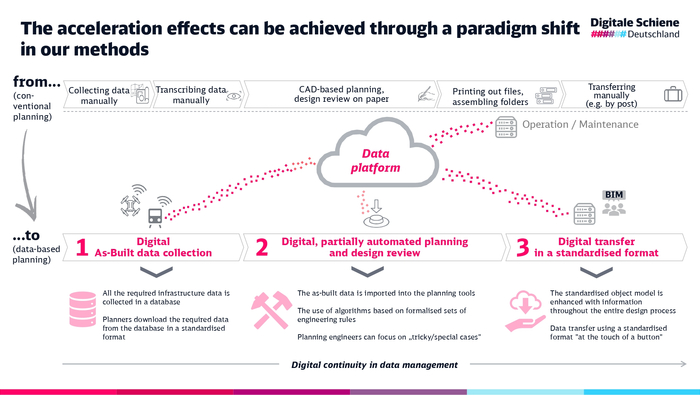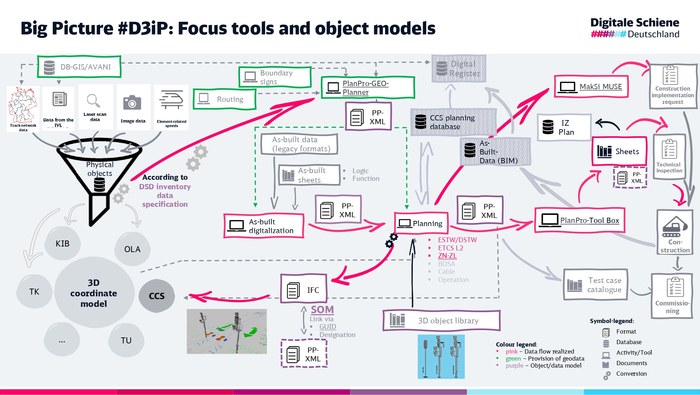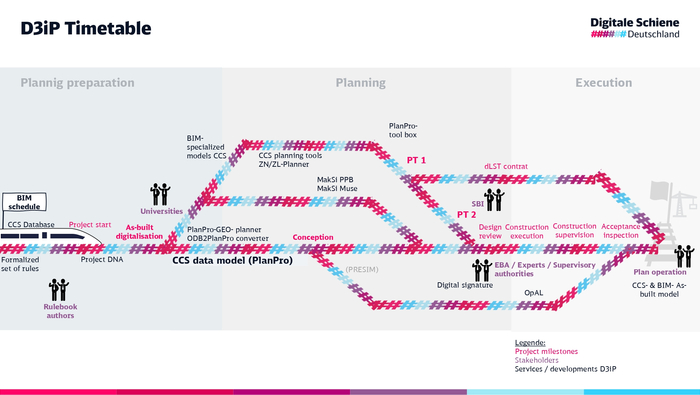
Consistent Digital Data Management in CCS Planning (D3iP)
The D3iP project acts as an acceleration measure for the rollout of DSTW and ETCS by standardising and digitalising the planning process and speeding it up as much as possible through future end-to-end digital data management.
Project duration
Contact
Disclaimer
The dates shown are legally non-binding forecasts based on the current status. The forecasts are in no way intended to establish any kind of legal claim whatsoever that completion will take place by the specified date and that use will be possible. For these reasons, the information should also not be used to make or prepare business decisions, for example, but not conclusively, with regard to the vehicle equipment or the compatibility between the vehicles and the infrastructure. If you have any questions, particularly regarding technical network access or obtaining binding information, please contact your customer advisor.
The D3iP project acts as an acceleration measure for the rollout of DSTW and ETCS by standardising and digitalising the planning process and speeding it up as much as possible through future end-to-end digital data management. We are utilising this unique opportunity to set up the planning process in a sustainable and forward-looking way and thus provide employees with greater support in the long term.
What is to be achieved with D3iP?
The objectives of the project can be divided into the following three dimensions:
- automated recording of the existing infrastructure and data processing in the sense of Building Information Modeling (BIM),
- (partial) automation of planning processes and technical support for the specialist review and
- digital transfer of planning results.
D3iP thus enables a uniform, data-based planning process with standardised data interfaces.

The PlanPro data format is the standard for data exchange. By implementing the data model in software applications, we enable transparency and quality in project management as well as a standardised documentation basis. We simplify the exchange of information and data from the start of the project up to commissioning.
What does D3iP do?
D3iP achieves sustainable acceleration effects through the introduction of consistent digital data management in the CCS planning process. This is achieved through the development of a standardised data model in conjunction with a quality-assuring tool chain and the adaptation of existing processes. The subject areas include the recording of the entire process (consistent/end-to-end), data management and IT. All of these areas are considered holistically in the context of Building Information Modeling (BIM).

Basically, this includes:
- converting the planning process from a paper-based to a digital database by adapting existing processes and procedures,
- digitising the requirements documents of Digitale Schiene Deutschland (DSD) using a digitally standardised procedure,
- the development of tool solutions for the early determination of blocking requirements for underground cable construction, cable laying, DSTW, ETCS equipment with balises, level crossings and test and acceptance runs for ETCS,
- carrying out future acceptance tests using standardised, digital documentation (instead of on-site inspections and manual measurements),
- the creation of central data storage for LST planning data in the PlanPro data format through the development of data/object models and a database solution (including tool solutions and an interface definition for data exchange) across the entire planning process,
- supporting a consistent digital data management in the CCS planning through a "software suite" that includes software tools and tools for creating and processing planning data,
- the creation of consistency and seamless coordination of planning results between digital LST planning and Building Information Modeling (BIM) and
- the active support of real (pilot) projects such as the DSD starter package and the joint "testing" of the various use cases of 3D, 4D and 5D planning, including the processes, tools and formats developed by D3iP.

What are the benefits of D3iP?
A consistent digital data management in the CCS planning process has the following advantages:
- creation of optimisation potential, such as the parallelisation of activities and the achievement of time savings within the data exchange (e.g. printing and dispatch time) between the processors,
- achieving acceleration effects in the creation of tasks for planning services,
- early determination of requirements and visualisation for construction areas and closure times through digital transfer of planning data,
- standardised and automated creation of site plans and tables for visualising planning content,
- increased quality and thus acceleration, as all tools exchange data on the basis of a standardised interface, thus avoiding transmission errors and inconsistencies,
- early recognition of correlations, conflicts and opportunities for cross-trade planning through collaborative work, i.e. with the help of intelligent data management and model-based working methods, users receive exactly the information they need at any given time.
Conclusion

„Working on these project action areas will lead us to the goal of establishing consistent digital data management in the CCS planning process by 2028. Through the standardisation and partial automation of the systems and the planning process, we achieve acceleration effects for the DSD rollout and can thus implement more projects more efficiently (e.g. through shorter runtimes) and, above all, more value-adding (consistent conversion/entry into the digital value chain).
Dr.-Ing. Volkmar Bachmann, Project Manager D3iP
Vision:
"Within five years, we have established consistent digital data management in the CCS planning process (D3iP). By standardising and automating the systems and the planning process, we have achieved acceleration effects for the DSD rollout and can thus implement more projects more efficiently (e.g. shorter duration) and, above all, more value-adding (a consistent conversion/entry into the digital value chain)."
Greater objective of the project:
The D3iP project is one of the four acceleration measures* on the successful implementation of the DSD rollout. The aim of the D3iP project is to standardise the planning processes and accelerate them as much as possible through consistent digital data management.
* 1. acceleration through automation of planning | 2. acceleration through standardisation of technology | 3. acceleration and increased safety through optimised technology management | 4. acceleration through innovative testing and approval processes
Detailed objectives of the project:
The detailed objectives are divided into three dimensions:
- automated recording of the existing infrastructure and data processing in the sense of Building Information Modeling (BIM),
- (partial) automation of planning processes and technical support for the specialist review and
- digital transfer of planning results.
Film off for D3iP
- PlanPro at DB InfraGO AG (in German only)
- D3iP lecture at Safety Technology Conference | Chair of Traffic Safety Engineering | TU Dresden (29/09/2022) (in German only)
- Building Information Modeling at DB AG (in German only)
- Publication: Acceleration of LST planning in the digital Stuttgart node (in German only)